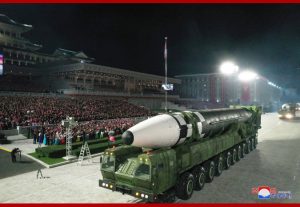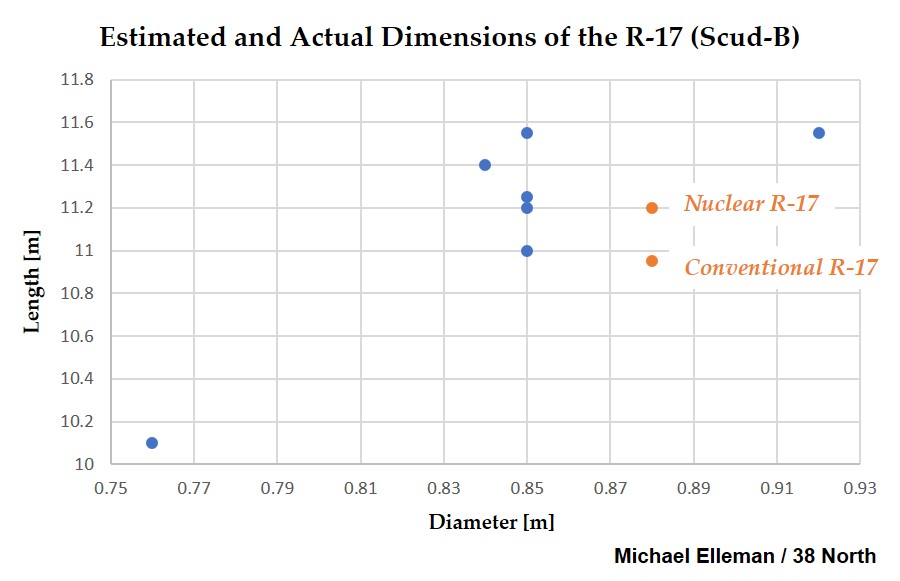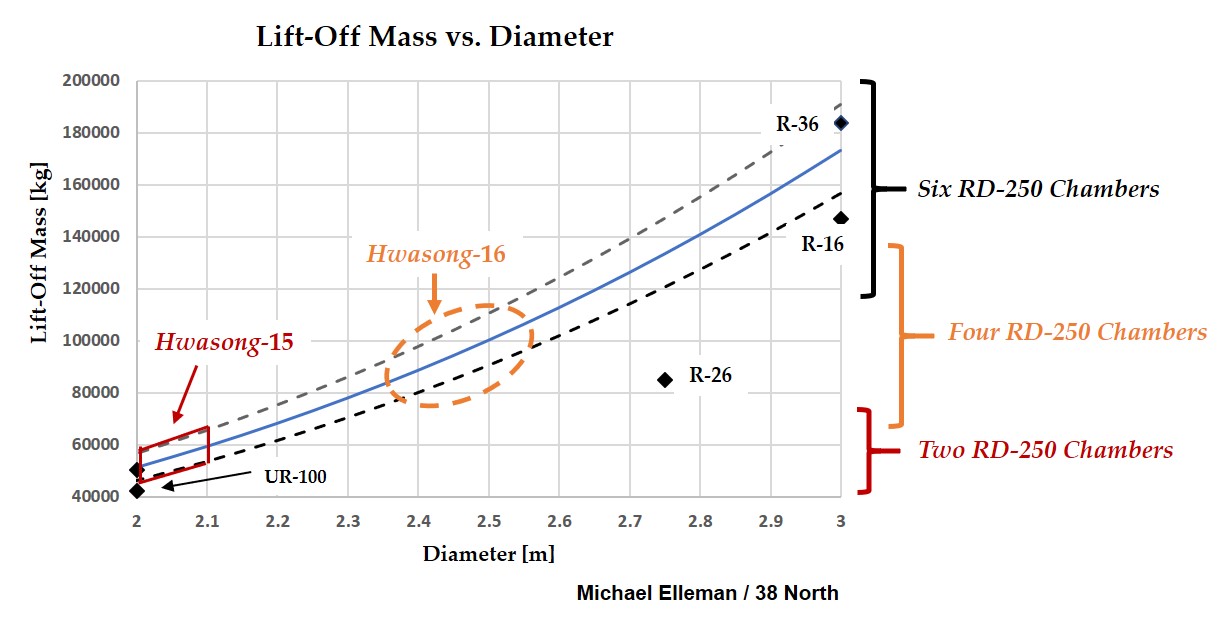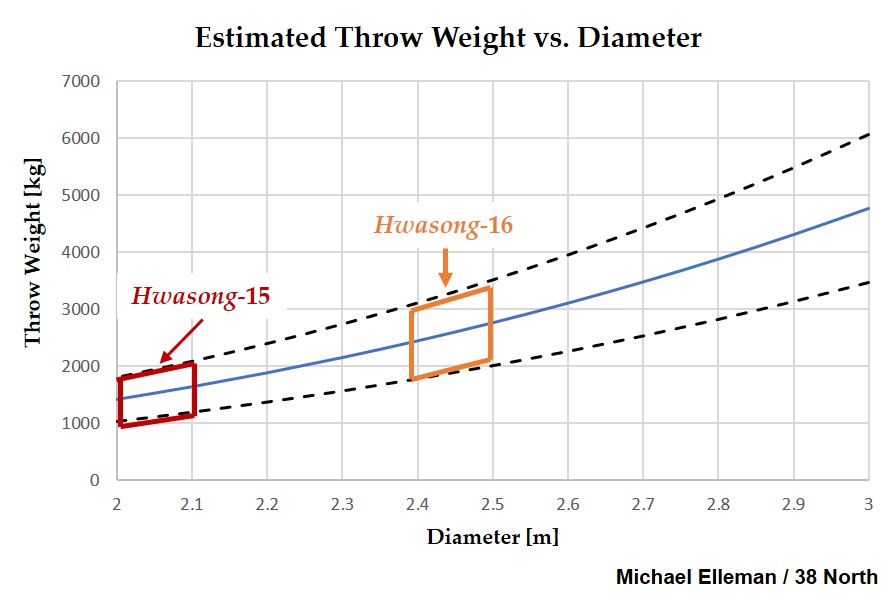Does Size Matter? North Korea’s Newest ICBM

During its October 10 celebration of the 75th anniversary of the founding of the Workers’ Party of Korea, North Korea paraded its newest and biggest long-range ballistic missile. Described as a “monster,” the presumptive Hwasong-16 is considerably larger than the Hwasong-15 intercontinental ballistic missile (ICBM) that was test launched in November 2017. Most of the initial commentary speculated the new missile, which has not been flight tested, is designed to carry multiple warheads and decoys to ensure the penetrability of America’s missile defenses. Others have gone further, suggesting the new missile will be armed with multiple independently-targetable reentry vehicles (MIRVs).
The analysis presented here suggests that, while the new missile has the thrust to deliver a heavy payload over intercontinental distances, its mobility is going to be severely limited by its tremendous size and weight. Moreover, the Hwasong-16 is too heavy and brittle to be transported safely when fully fueled, so must be fueled at the launch site after it has been erected—a process requiring several hours to complete. Consequently, the missile would be vulnerable to pre-launch attack. Furthermore, developing MIRV technology is no easy task, and will require further development of missile and guidance systems and significant flight testing.
The bottom line is that the Hwasong-16 will need to undergo flight trials conducted over a couple of years to validate its performance and reliability. Taking these factors into account, North Korea is probably years away from having a reliable, highly survivable and operational MIRVed ICBM capability, if that is indeed its intention.
Is the Hwasong-16 a Real Missile?
North Korea has a history of introducing “fake” missiles during celebratory parades, so it is appropriate to question the authenticity of the Hwasong-16 presented earlier this month. In 2012, North Korea paraded a handful of poorly built, incorrectly configured mock-ups of a new Hwasong-13 long-range missile. The poor quality of those mock-ups had some analysts conclude they were fake and did not represent an operational missile, but could signal North Korea’s long-term ambitions.
The mock-ups shown off in 2015 were of higher quality, suggesting a mature missile design and the possible initiation of flight tests of prototype missiles within a few years. The Hwasong -14 and -15 ICBMs North Korea flight tested in 2017, however, were not fully consistent with the models paraded in 2015, which is consistent with missile development elsewhere. Missile designs evolve during the development process, including during flight trials which reveal design flaws requiring alterations to the design.
The mock-ups presented on October 10 are similar in quality to those paraded in 2015, possibly indicating that North Korea could soon begin flight trials of the notional Hwasong-16. However, as with the Hwasong-14 and -15, one should expect to see minor modifications of the Hwasong-16 when it is initially flight tested.
How Big Is the Hwasong-16?
If a missile’s design documents or technical manuals are available, or if physical access can be gained to the missile to measure its diameter and length, a precise determination of its size can be made. Without such access, one must rely on photographs and other indirect sources for estimating a missile’s dimensions. The resulting estimates will contain errors, the magnitude of which must be included in any missile analysis.
Historically, dimensional data extracted from photographs, videos and other indirect measures contain errors of about five to ten percent, relative to the actual values. This is vividly illustrated in Figure 1, where estimates of the diameter and length of the R-17 (Scud-B) published in declassified intelligence reports, academic studies and the media are given. The estimates were never precise, but they were close enough to allow analysts to create a computational model capable of projecting the R-17’s range and throw-weight parameters.

Estimates of the Hwasong-16’s diameter derived from photographs taken during the October 10 parade vary. But two values developed by experienced specialists seem reasonable. They indicate a Hwasong-16 diameter ranging between 2.4 and 2.5 meters, and a length of roughly 24 to 25 meters. These data can be used to estimate the missile’s lift-off mass by assuming the Hwasong-16 has an average density consistent with Soviet and American liquid-fuel missile designs from the 1960s and 1970s. Figure 2 plots mass estimates for the missile as a function of diameter, with the upper and lower bounds indicated; if its diameter falls within the 2.4 to 2.5-m estimate, the Hwasong-16’s total mass, when fully fueled, is somewhere between 80,000 and 110,000 kg.

Using the same methodology, and applying it to the Hwasong-15, which has an estimated diameter between 2.0 and 2.1 meters, we get an estimated starting mass between 50,000 and 60,000 kg, which is consistent with reconstructions of the missile using initial acceleration data and the reported burn times for the first and second stages.
How Much Payload Can It Deliver To the US Mainland?
The Hwasong-16’s first-stage propulsion system cannot be directly determined from the available photographs. Presumably, North Korean engineers would seek to use the same RD-250 engine technology that successfully boosted the Hwasong-12, -14 and -15 missiles. Unlike the Hwasong-15, which relied on an engine consisting of two combustion chambers, the heavier Hwasong-16 would require four combustion chambers to attain an initial acceleration similar to those achieved by liquid-fuel ICBM designs fielded by others, as well as the Hwasong-15. A Hwasong-16’s first-stage diameter of 2.4 to 2.5 meters is large enough to house a cluster of four RD-250 chambers, but not a six-chamber configuration.
The Hwasong-16’s second stage appears to be quite small relative to the first stage, as was the case for the Hwasong-15. The first- to second-stage size ratio appears to be just under five-to-one for both ICBM designs. Liquid-fuel ICBMs fielded by others had considerably lower ratios (between 2.6-to-1 and 4-to-1), indicating they employed significantly larger, more powerful second stages than the presumptive Hwasong-16 design. The second stage’s relatively small size suggests North Korea will employ the low-thrust R-27 steering engines. If this is the case, the Hwasong-16’s throw weight will be at the lower end of the projections shown in Figure 3. The reduced performance results from the use of low-thrust, long-action time engines, which are likely to suffer greater gravitational losses than would higher-thrust engines.

These propulsion system configurations for the Hwasong-16 are far from certain. Available photographs do not reveal the types and number of engines North Korea plans to incorporate into the first and second stages. Consequently, we cannot develop a computational model of the Hwasong-16 to confidently calculate the missile’s maximum range for a defined payload mass. However, by examining the ratio of payload mass to lift-off mass of liquid-fuel ICBMs developed by others we can a throw-weight for the new Korean missile, assuming it is designed to achieve the same range capacity as the smaller Hwasong-15.
The estimate throw-weight as a function of diameter (i.e., lift-off mass) is plotted in Figure 3. The plot suggests the Hwasong-16 can deliver a payload of about 2,500 to 3,000 kg to any target on the US mainland, which is almost double the Hwasong-15’s throw-weight of about 1,500 kg. The estimate’s bandwidth, however, shows that the throw-weight might be considerably more or less than the baseline case.
If the Hwasong-16’s second stage is equipped with under-powered engines used on the upper stages of the Hwasong-14 and -15, these projections will trend toward the lower end of the bandwidth estimate shown in Figure 3.
Regardless of the uncertainties for the projected throw-weight estimate, the Hwasong-16 should have the capacity to deliver either a very large warhead, or two to four smaller reentry vehicles containing a miniaturized bomb design. A large warhead accompanied with light-weight decoys to confound US missile defense systems is another possible configuration.
If a multiple reentry vehicle design is sought, North Korea will need to employ slender, highly streamlined reentry vehicles to fit them into the limited volume under the payload shroud. Streamlined reentry vehicles travel through the atmosphere at higher speeds than their blunt-nosed counterparts, requiring a more sophisticated protection scheme to ensure the nuclear warhead survives the intense thermal and mechanical loads experienced during reentry. It is unclear if North Korea has mastered reentry technologies for its Hwasong-14 and -15 missiles. Mastering the technologies for streamlined reentry vehicles will increase the already daunting challenges North Korea’s engineers face.
Will the Hwasong-16 Be MIRVed?
The development of MIRV technology is not easy. It requires a combination of large missiles, small warheads, accurate guidance and a complex mechanism for releasing warheads sequentially during flight. North Korea will also have to develop a bus to carry and release the reentry vehicles. It took the US more than five years to perfect its MIRV capability for the Minuteman ICBM in the late-1960s. The Soviets required a similar amount of time. Further, flight testing will be needed to evaluate and validate a North Korean system, which in turn requires the placement of telemetry reception ships along the ground track of the missile’s flight path. It is unclear if North Korea has such ships it can position far from the peninsula.
Deployment Challenges
The Hwasong-16, if operationalized, would be without question the largest liquid-fuel, road-mobile missile ever developed and deployed. The combined weight of the missile and its 11-axle transporter-erector launcher (TEL) will restrict transport to North Korea’s limited network of paved roadways. It might be possible to travel short distances on some dirt roads, but only if they have not been subjected to rain or snow. Further, it is highly unlikely that the Hwasong-16 (and likely its smaller counterparts, the Hwasong-12, -14 and -15) can be fueled at a secure garrison and then driven to a pre-surveyed site where it can be erected and quickly prepared for launch. The inevitable vibrations a fully loaded missile experiences during road travel are liable to crack open seams and joints, leaking highly volatile fuel and oxidizer and leading to a serious incident.[1]
Perhaps North Korea does not intend to make the missile ‘road-mobile’ and instead plans to deploy them in highly protected underground sites, where it can be quickly rolled out, fueled, and then launched. The fueling process would require a few hours unless specialized pumps are available to quicken the process. Relying on fixed, underground sites would obviate the need to travel on roads and would allow the North Koreans to position the fuel and oxidizer storage tanks, along with the specialized pumps, adjacent to the launch pad for rapid, on-site fueling.
Why Now?
As mentioned above, the Hwasong-16 missile revealed this month featured enough detail to suggest the North Koreans are engineering models that could undergo flight tests in the next year or two. It remains puzzling, however, why the North expended precious resources to develop and build an ICBM of this size and potential capability. Concerns about US missile defenses are warranted, despite the poor test record of the ground-based interceptors deployed in Alaska and California. But if North Korea is worried that it might not be able to penetrate the defenses and reliably land a warhead on the US mainland, it seems reasonable its leaders would want to ensure the dependability of its missile forces. After just one flight test of the Hwasong-15 on a highly lofted, unrepresentative trajectory, along with no discernible proof that the reentry vehicle survived, the regime has no measure of the missile’s reliability.
Historical precedence indicates that over half of the Hwasong-15s launched in a crisis would fail. Given the tenuous operational status of the Hwasong-15, and the apparent desire to ensure warheads launched toward the US would successfully arrive on target, it seems more reasonable to continue flight tests to work out the design flaws and quantify its performance and reliability before beginning to design and test a more sophisticated ICBM.
Conclusion
As it stands today, Kim Jong Un cannot be certain that his ICBMs will succeed in striking the US mainland. Perhaps the development of the Hwasong-16 is a near-term solution to the perceived need for a mobile, multiple-warhead ICBM. But North Korea has an active solid-fuel development and production infrastructure in place to facilitate the creation of large solid-fuel boosters for an ICBM. Thus, a more prudent and cost-effective path forward would focus on the longer-term development of solid-fuel technologies and a solid ICBM. In a best-case scenario, it will take longer than four or five years to succeed in this enterprise. The resulting ICBM, however, would be far more survivable and operationally flexible than a Hwasong-16, which will have limited mobility. Which direction the North’s ICBM development program will take remains to be seen.
- [1]
Concerns about the mechanical integrity of liquid-fuel missiles deployed on mobile platforms contributed to the Soviet decision to abandon attempts to develop a train-mobile version of the liquid-fuel R-16 ICBM in the mid-1960s, despite the pressing need to enhance pre-launch survivability of its ICBM forces by placing them on mobile platforms. Moscow concluded that a mobile ICBM force would have to rely on solid-fuel missiles. It was not until 1972 after the Soviet Union finally began to master the technologies needed to support the production of large, solid-fuel motors for the Temp-2S (SS-16) ICBM that road mobility was judged feasible. The first two Temp-2S regiments were operationalized in early 1976, after completion of a failure-filled, four-year flight test program.
